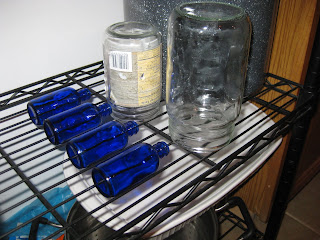





I'll start by saying, I never quite saw the use for making my own tinctures, they are certainly easy to find in health food stores, and I probably would trust the consistency and potency of a store bought one, more than I'd trust my own...but all that aside, not only is it very easy to do, it is kind of satisfying to know that in a pinch, you would know how to use the plants around you to help heal yourself. With everything up in the air with the healthcare debates, and the idea always being thrown around to more strictly regulate vitamins and herbs and supplements in general, it's nice to know that you could provide for yourself and your family if things started getting crazy...and the things you were used to depending on, became scarce.
Certain plants lend themselves to just making simple infusions (think "tea": putting the fresh or dried plant in boiled water), or decoctions (boiling the plant in the water for varying amounts of time, depending on the plant)...but if it's a plant you can ingest, you may want to tincture it to have a highly concentrated and stable form of it on hand for when the fresh plant isn't readily available (think winter, or when you're traveling).
So basically, all you need are some sterilized jars, some 100 proof alcohol (which means it's a 50/50 mix of alcohol and water--keep that one out of reach otherwise, it could do some damage to 'ya), and the plant material you would like to tincture (it can be fresh or dried).
I used the leaves of some first year Mullein plants (helpful for respiratory ailments, among other things), and some Lemon Balm (calming for anxiety, depression, insomnia), to make two separate tinctures.
I collected the plants, using only healthy looking plant parts, (in this case the leaves of the plants), cleaned them, finely chopped them, put them in the previously sterilized jar, and added twice the amount of alcohol, as plant solids. Then, I have been shaking them twice a day, while leaving them in the sunlight (a windowsill) and will continue to do so, for two weeks. Some say they will be more potent if you start them on the new moon (which I did) and end them on the full moon (which I plan to). It's also not a bad idea to think about the ways they can help heal as you shake them...I know, it sounds wacky, but it can't hurt. At the end of the two weeks, I will strain them through some clean muslin, and transfer them to dark bottles, filling them as full as possible to avoid oxygen breaking them down, and store them in a cool dark place.

